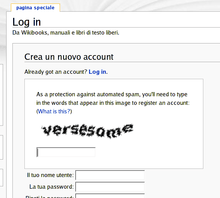Spambot

A spambot is an automated computer program designed to assist in the sending of spam. Spambots usually create fake accounts and send spam using them, although in many cases it would be obvious that a spambot is sending it. This has led to the development of password-cracking spambots that are able to send spam using other people's accounts.
E-mail spambots
E-mail spambots harvest e-mail addresses from material found on the Internet in order to build mailing lists for sending unsolicited e-mail, also known as spam. Such spambots are web crawlers that can gather e-mail addresses from websites, newsgroups, special-interest group (SIG) postings, and chat-room conversations. Because e-mail addresses have a distinctive format, spambots are easy to write.
A number of programs and approaches have been devised to foil spambots. One such technique is address munging, in which an e-mail address is deliberately modified so that a human reader (and/or human-controlled web browser) can interpret it but spambots cannot. This has led to the evolution of more sophisticated spambots that are able to recover e-mail addresses from character strings that appear to be munged, or instead can render the text into a web browser and then scrape it for e-mail addresses. Alternative transparent techniques include displaying all or part of the e-mail address on a web page as an image, a text logo shrunken to normal size using inline CSS, or as text with the order of characters jumbled, placed into readable order at display time using CSS.
Forum spambots
Forum spambots surf the web, looking for guestbooks, wikis, blogs, forums, and other types of web forms that it can then use to submit bogus content. These often use OCR technology to bypass CAPTCHAs. Some spam messages are targeted towards readers and can involve techniques of target marketing or even phishing, making it hard to tell real posts from the bot generated ones. Other spam messages are not meant to be read by humans, but are instead posted to increase the number of hyperlinks to a particular web site, to boost its search engine ranking.
This category of spambot has gained considerable notoriety since November 2006, with the introduction of XRumer, a forum and wiki spambot which can often bypass many of the safeguards administrators use to reduce the amount of spam posted.
One way to prevent spambots from creating automated posts is to require the poster to confirm their intention to post via e-mail. Since most spambot scripts use a fake e-mail address when posting, any email confirmation request is unlikely to be successfully routed to them. Some spambots will pass this step by providing a valid email address and use it for validation, mostly via webmail services. Using methods such as security questions are also proven to be effective in curbing posts generated by spambots, as they are usually unable to answer it upon registering.
Twitter spambots
E-mail blockers
The term spambot sometimes has an inverse meaning, referring to a program designed to prevent spam from reaching the subscribers of an Internet service provider (ISP). Such programs are more often called e-mail blockers or filters.
Blocking software may inadvertently prevent a legitimate e-mail message from reaching a subscriber. This can be prevented by allowing each subscriber to generate a whitelist, a list of specific e-mail addresses the blocker should let pass.
See also
- Botnet
- List poisoning
- Spamtrap
- Spider trap
- Stopping e-mail abuse
References
External links
| Look up spambot in Wiktionary, the free dictionary. |
- Stas Bekman's Article on Botnets and how they are used for spamming
- Botnet discussion mailing list
- Harvester Killer – Fight back at spambots
- Fight Spam - Join Byteplant's Spambot Honeypot Project
- BotScout: Anti-bot service dedicated to fighting forum spam
- Spambot Beware! - information on how to avoid, detect, and harass spambots
- Bot-trap - A Bad Web-Robot Blocker
- How to block spambots
| ||||||||||||||||||||||||